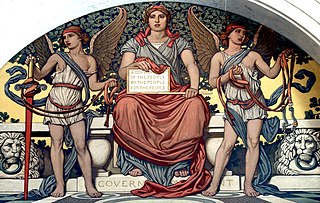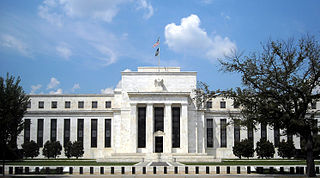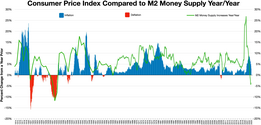
Macroeconomics is a branch of economics that deals with the performance, structure, behavior, and decision-making of an economy as a whole. This includes regional, national, and global economies. Macroeconomists study topics such as output/GDP and national income, unemployment, price indices and inflation, consumption, saving, investment, energy, international trade, and international finance.

In economics, inflation is a general increase in the prices of goods and services in an economy. This is usually measured using the consumer price index (CPI). When the general price level rises, each unit of currency buys fewer goods and services; consequently, inflation corresponds to a reduction in the purchasing power of money. The opposite of CPI inflation is deflation, a decrease in the general price level of goods and services. The common measure of inflation is the inflation rate, the annualized percentage change in a general price index. As prices faced by households do not all increase at the same rate, the consumer price index (CPI) is often used for this purpose.

Monetarism is a school of thought in monetary economics that emphasizes the role of policy-makers in controlling the amount of money in circulation. It gained prominence in the 1970s, but was mostly abandoned as a practical guidance to monetary policy during the following decade because the strategy was found to not work very well in practice. Instead, inflation targeting through movements of the official interest rate became the dominant monetary policy strategy.

In economics and political science, fiscal policy is the use of government revenue collection and expenditure to influence a country's economy. The use of government revenue expenditures to influence macroeconomic variables developed in reaction to the Great Depression of the 1930s, when the previous laissez-faire approach to economic management became unworkable. Fiscal policy is based on the theories of the British economist John Maynard Keynes, whose Keynesian economics theorised that government changes in the levels of taxation and government spending influence aggregate demand and the level of economic activity. Fiscal and monetary policy are the key strategies used by a country's government and central bank to advance its economic objectives. The combination of these policies enables these authorities to target inflation and to increase employment. In modern economies, inflation is conventionally considered "healthy" in the range of 2%–3%. Additionally, it is designed to try to keep GDP growth at 2%–3% percent and the unemployment rate near the natural unemployment rate of 4%–5%. This implies that fiscal policy is used to stabilise the economy over the course of the business cycle.
The Phillips curve is an economic model, named after Bill Phillips, that correlates reduced unemployment with increasing wages in an economy. While Phillips did not directly link employment and inflation, this was a trivial deduction from his statistical findings. Paul Samuelson and Robert Solow made the connection explicit and subsequently Milton Friedman and Edmund Phelps put the theoretical structure in place.

In macroeconomics, the money supply refers to the total volume of money held by the public at a particular point in time. There are several ways to define "money", but standard measures usually include currency in circulation and demand deposits. Money supply data is recorded and published, usually by the national statistical agency or the central bank of the country. Empirical money supply measures are usually named M1, M2, M3, etc., according to how wide a definition of money they embrace. The precise definitions vary from country to country, in part depending on national financial institutional traditions.

Monetary policy is the policy adopted by the monetary authority of a nation to affect monetary and other financial conditions to accomplish broader objectives like high employment and price stability. Further purposes of a monetary policy may be to contribute to economic stability or to maintain predictable exchange rates with other currencies. Today most central banks in developed countries conduct their monetary policy within an inflation targeting framework, whereas the monetary policies of most developing countries' central banks target some kind of a fixed exchange rate system. A third monetary policy strategy, targeting the money supply, was widely followed during the 1980s, but has diminished in popularity since that, though it is still the official strategy in a number of emerging economies.
The Taylor rule is a monetary policy targeting rule. The rule was proposed in 1992 by American economist John B. Taylor for central banks to use to stabilize economic activity by appropriately setting short-term interest rates. The rule considers the federal funds rate, the price level and changes in real income. The Taylor rule computes the optimal federal funds rate based on the gap between the desired (targeted) inflation rate and the actual inflation rate; and the output gap between the actual and natural output level. According to Taylor, monetary policy is stabilizing when the nominal interest rate is higher/lower than the increase/decrease in inflation. Thus the Taylor rule prescribes a relatively high interest rate when actual inflation is higher than the inflation target.
The quantity theory of money is a theory from monetary economics which states that the general price level of goods and services is directly proportional to the amount of money in circulation, and that the causality runs from money to prices. This implies that the theory potentially explains inflation. It originated in the 16th century and has been proclaimed the oldest surviving theory in economics.
Neutrality of money is the idea that a change in the stock of money affects only nominal variables in the economy such as prices, wages, and exchange rates, with no effect on real variables, like employment, real GDP, and real consumption. Neutrality of money is an important idea in classical economics and is related to the classical dichotomy. It implies that the central bank does not affect the real economy by creating money. Instead, any increase in the supply of money would be offset by a proportional rise in prices and wages. This assumption underlies some mainstream macroeconomic models. Others like monetarism view money as being neutral only in the long run.

The Federal Reserve System has faced various criticisms since it was authorized in 1913. Nobel laureate economist Milton Friedman and his fellow monetarist Anna Schwartz criticized the Fed's response to the Wall Street Crash of 1929 arguing that it greatly exacerbated the Great Depression. More recent prominent critics include former Congressman Ron Paul.
In economics, the Fisher effect is the tendency for nominal interest rates to change to follow the inflation rate. It is named after the economist Irving Fisher, who first observed and explained this relationship. Fisher proposed that the real interest rate is independent of monetary measures, therefore, the nominal interest rate will adjust to accommodate any changes in expected inflation.

The Friedman rule is a monetary policy rule proposed by Milton Friedman. Friedman advocated monetary policy that would result in the nominal interest rate being at or very near zero. His rationale was that the opportunity cost of holding money faced by private agents should equal the social cost of creating additional fiat money. Assuming that the marginal cost of creating additional money is zero, nominal rates of interest should also be zero. In practice, this means that a central bank should seek a rate of inflation or deflation equal to the real interest rate on government bonds and other safe assets, to make the nominal interest rate zero.
In macroeconomics, inflation targeting is a monetary policy where a central bank follows an explicit target for the inflation rate for the medium-term and announces this inflation target to the public. The assumption is that the best that monetary policy can do to support long-term growth of the economy is to maintain price stability, and price stability is achieved by controlling inflation. The central bank uses interest rates as its main short-term monetary instrument.
In macroeconomics, discretionary policy is an economic policy based on the ad hoc judgment of policymakers as opposed to policy set by predetermined rules. For instance, a central banker could make decisions on interest rates on a case-by-case basis instead of allowing a set rule, such as Friedman's k-percent rule, an inflation target following the Taylor rule, or a nominal income target to determine interest rates or the money supply. In practice, most policy actions are discretionary in nature.
In monetary economics, the demand for money is the desired holding of financial assets in the form of money: that is, cash or bank deposits rather than investments. It can refer to the demand for money narrowly defined as M1, or for money in the broader sense of M2 or M3.
Inflationary bias is the outcome of discretionary monetary policy that leads to a higher than optimal level of inflation. Depending on the way expectations are formed in the private sector of the economy, there may or may not be a transitory income increase. The term may also refer to the practice of a public debt-ridden nation enacting policies which encourage inflation in the medium/long term.
Market monetarism is a school of macroeconomic thought that advocates that central banks target the level of nominal income instead of inflation, unemployment, or other measures of economic activity, including in times of shocks such as the bursting of the real estate bubble in 2006, and in the financial crisis that followed. In contrast to traditional monetarists, market monetarists do not believe monetary aggregates or commodity prices such as gold are the optimal guide to intervention. Market monetarists also reject the New Keynesian focus on interest rates as the primary instrument of monetary policy. Market monetarists prefer a nominal income target due to their twin beliefs that rational expectations are crucial to policy, and that markets react instantly to changes in their expectations about future policy, without the "long and variable lags" postulated by Milton Friedman.
Smartbond is a monetary system, based on a currency of the same name, which operates independently of any government institution.
A Program for Monetary Stability is a book by the US economist Milton Friedman. It has been published by Fordham University Press in 1960 with consecutive re-prints appearing in 1961, 1963, 1965, 1969, 1970, 1975, and 1980. In the Prefatory Note Friedman states that the book is a revised and expanded version of the third of the Moorhouse I. X. Millar Lecture Series, which he gave at Fordham University in October 1959. At the same time, he claims that the book has resulted from the joint research with Anna Schwartz under the NBER project.








